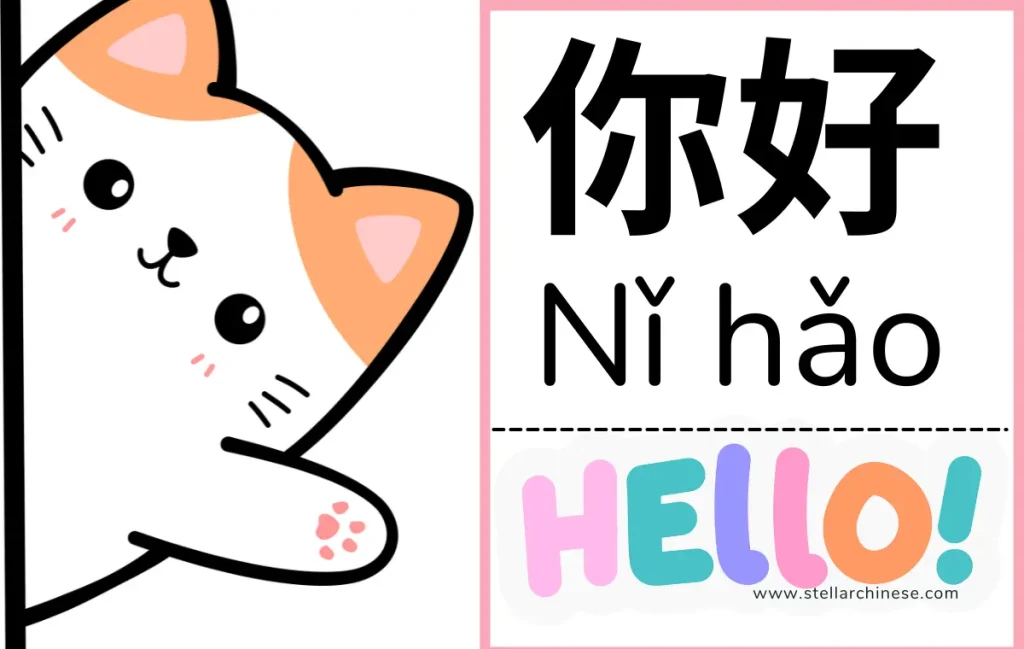You’ve already nailed how to say goodbye and thank you, and you’re welcome in Chinese.
Great job! Now, let’s tackle the first thing you’d say to anyone: hello!
Whether you’re gearing up for a trip to China, chatting with Mandarin-speaking friends, or just having fun learning a new language, knowing how to greet someone properly is key.
The good news? It’s super simple, and by the end of this guide, you’ll be greeting people in Chinese like a pro!
Read further:
- Master Chinese Pronunciation with Pinyin
- Build Confidence with These Simple Chinese Sentences
- Expand Your Vocabulary with These 199+ Essential Chinese Words
- How to Use “Le” in Chinese Like a Native Speaker
- Beautiful and Poetic Ways to Express Love in Chinese
How Do You Say Hello in Chinese?
Chinese greetings vary depending on the context, the relationship between speakers, and even the time of day. A simple hello can convey warmth, respect, or friendliness, depending on how you say it.
Let’s dive into 27 ways to say hello in Chinese, along with cultural insights, examples, and when to use each one!
Standard Greetings
1. 你好 (Nǐ hǎo) – The most common way to say hello. Works in almost any setting, whether meeting someone for the first time or greeting a stranger politely.
2. 您好 (Nín hǎo) – A polite and respectful way to greet someone, often used when addressing elders, teachers, or in professional settings. In Chinese culture, using 您 (Nín) instead of 你 (Nǐ) shows extra politeness and deference, making it ideal for workplace interactions, speaking to clients, or addressing someone of higher status.
3. 哈喽 (Hā lóu) – A casual, borrowed version of “Hello.” Used mostly in texts, chats, or informal conversations.
4. 嗨 (Hāi) – The Chinese equivalent of “Hi,” great for casual interactions with friends.
5. 喂 (Wèi) – Used when answering the phone. Instead of saying “Hello,” people in China say 喂. When answering the phone, native speakers often pronounce it with a second tone (wéi), making it sound more friendly and inviting.
6. 很高兴认识你 (Hěn gāo xìng rèn shì nǐ) – “Nice to meet you!” This greeting is typically used when meeting someone for the first time. It’s a polite and friendly way to express pleasure in making a new acquaintance. While it’s not a direct replacement for “hello,” it’s often used right after initial greetings like 你好 (Nǐ hǎo) in formal or semi-formal settings.
Time-Based Greetings
7. 早上好 (Zǎo shàng hǎo) – Good morning. A polite greeting when starting the day, used in workplaces or formal settings.
8. 早安 (Zǎo ān) – A shorter, slightly more formal version of “Good morning,” often used in Taiwan or written messages.
9. 上午好 (Shàng wǔ hǎo) – Good morning (late morning). Appropriate between 10 AM and noon, especially in work environments.
10. 下午好 (Xià wǔ hǎo) – Good afternoon. Suitable for greeting colleagues or acquaintances after lunch.
11. 晚上好 (Wǎn shàng hǎo) – Good evening. Often used when meeting someone in the evening, such as at a dinner gathering.
12. 晚安 (Wǎn ān) – Good night. Mostly used in written form or as a bedtime farewell.
Other Greetings
13. 嘿 (Hēi) – “Hey!” A relaxed way to greet close friends.
14. 哈喽哈喽 (Hā lóu hā lóu) – A playful “Hello, hello!” Often seen in text messages or online chats.
15. 你好吗? (Nǐ hǎo ma?) – “How are you?” Less commonly used in Chinese than in English; typically reserved for more formal inquiries.
16. 最近怎么样? (Zuì jìn zěn me yàng?) – “How have you been?” Used when catching up with someone after a long time.
17. 吃了吗? (Chī le ma?) – “Have you eaten?” This greeting comes from the deep cultural belief that food is central to life, as expressed in the saying 民以食为天 (mín yǐ shí wéi tiān) – “Food is the most important thing for the people.”
Some of my friends find it strange when Chinese people greet them this way. In reality, it’s just a friendly way to ask how someone is doing. Once you understand this, it feels less unusual and more like a warm check-in, similar to asking, “How are you?” in English.
18. 干嘛呢? (Gàn má ne?) – “What’s up?” A casual way to check in with friends, commonly used in texts.
19. 在忙什么呢? (Zài máng shén me ne?) – “What are you up to?” Works well in friendly conversations over social media or messaging apps.
20. 怎么样? (Zěn me yàng?) – “How’s it going?” Functions similarly to English but usually doesn’t require a detailed answer.
Regional and Dialect-Based Greetings
21. 侬好 (Nóng hǎo) – “Hello” in Shanghainese. Using this in Shanghai can impress locals.
22. 你好嘞 (Nǐ hǎo lēi) – A Northern Chinese greeting, commonly heard in Beijing and northern provinces.
23. 哈咯 (Hā luō) – A casual “Hello” in some southern regions, especially Cantonese-speaking areas.
24. 哎哟 (Āi yō) – A friendly greeting expressing surprise, often used when seeing an old friend unexpectedly.
25. 嗨呀 (Hāi yā) – A cheerful way to say hi, full of enthusiasm.
Playful and Fun Greetings
26. 安安 (Ān ān) – A cute way to say hello online, often used in gaming communities or internet chats.
27. 哈 (Hā) – A super casual way to say hi, sometimes used in playful teasing.
Final Thoughts: Start Saying Hello in Chinese Today!
Now that you know 27 different ways to say hello in Chinese, start practicing!
The next time you meet a Chinese speaker, impress them with your greeting skills.
Found this helpful? Share it with your friends and help them learn too!
